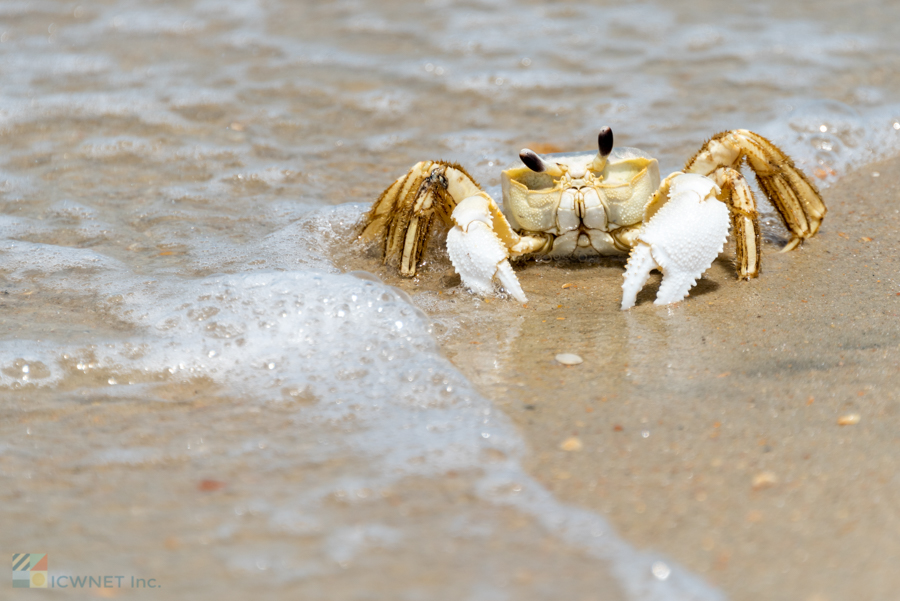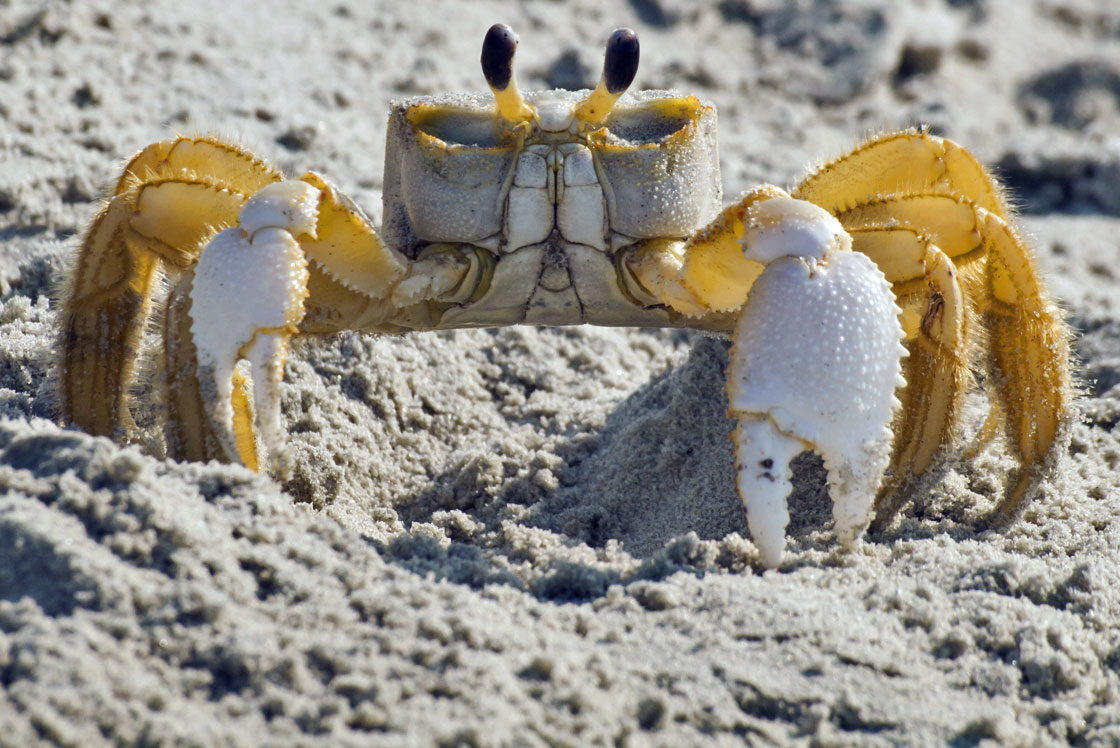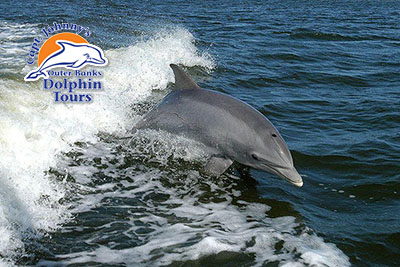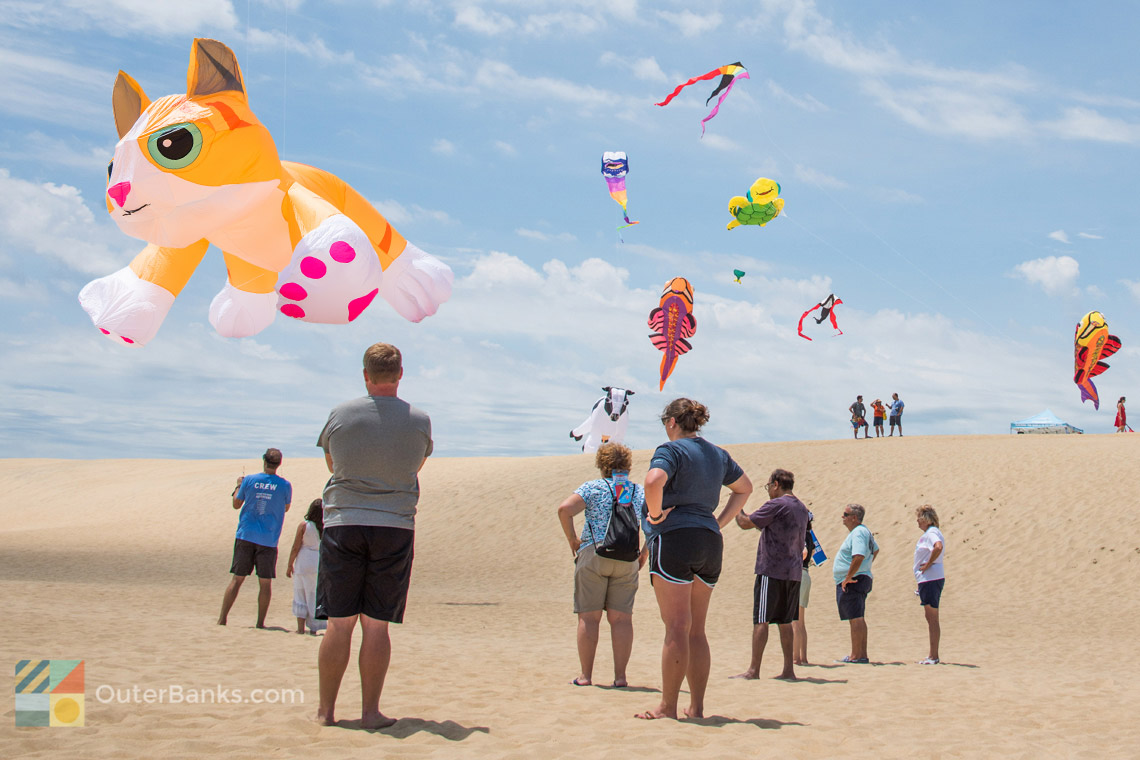We'd like to thank Captain Johnny's Dolphin Tours for supporting our ghost crabbing article. Visitors of all ages enjoy this two hour cruise in the protected waters of the Roanoke Sound. Learn about bottlenose dolphins, then see them in person with a 98% success rate. Several tour times are available Monday thru Friday, May to October. Morning tours, sunset cruises and private tours are available. Visit their site here or call 252-473-1475 for more information.
Interested in the local Outer Banks nightlife? Head to the sand. One of the most popular after-dark activities on the OBX beaches is ghost crab hunting, and all a prospective OBX hunter needs to participate is a flashlight and a love of the beach.

Ghost crabs are small, almost iridescent critters that call the shoreline's ocean wash to the high tide line home, and at night, they come out in droves combing the beaches for a late dinner. Vacationers who want to get up-close-and-personal with the local wildlife need only to visit the oceanfront after the sun sets, turn on the flashlight, and watch the local ghost crab population scatter.
Aptly named due to their inherent nocturnal habits, ghost crabs are a little-known but well-loved local attraction that every vacationer has the opportunity to meet and greet. On your next vacation, take a mini expedition of your own and introduce yourself to these skittish but abundant local natives.

About the Outer Banks Ghost Crabs
There are technically over 20 species of ghost crabs roaming earth's shorelines. The variety you'll spot most along the Outer Banks is the Atlantic Ghost Crab, which shares many characteristics with the fiddler crab, also found all along the coastal North Carolina area along muddy soundside areas or hidden next to salty canals.
Ghost crabs are on average about 2" wide across, (although avid ghost crab hunters have been known to find a few that are 4" wide or more), feature long legs, and eyes that are perched on stalks and can rotate a full 360 degrees. Their name derives from their pale, sandy color, which makes them almost invisible against the shoreline until they start moving.
Ghost crabs essentially live on the beach, burrowing deep into the sand for protection from the blazing sun as well as passing predators. These burrows will only be a couple inches wide on the surface, and beach passer-bys may notice these small, half-dollar sized holes in the sand, but underneath the surface level, these intricate tracks can run up to 4' ft. deep, not including any outlying branches, allowing a network of protection from the elements. Despite being coastal North Carolina residents, ghost crabs are not big fans of the sunshine, and will spend most of their beach days tucked well inside their holes, or doing a bit of Summer cleaning" by popping out on occasion to remove any excess sand or debris.
Ghost crabs are notoriously shy, and with 360 degree vision, are very sensitive to any action that occurs around them. This is why many daytime beach goers will never encounter them, unless they are perfectly still, either taking a beachside nap, or lost in a good book. In these cases, a ghost crab may break out of an otherwise-unnoticeable hole in the sand to deposit some of the remnants of their cleaning efforts.
The ghost crab really stakes a beach claim at night, when the majority of the daily beach visitors have disappeared and the ghost crabs can enjoy the shoreline all to themselves. This is when the ghost crabs feed, foraging on coquina clams, mole or "sand crabs," or any other recently deceased small sea critter that washes up, and this is also when it seeks a mate.
Like most species, mating for ghost crabs is a competition, with the strongest male coming out the victor. Ghost crabs have a ritualized competition for a female ghost crab's affections, which involves a seemingly choreographed fight between two males, raising both their claws as well as their bodies in intimidating poses until one sinks into a submissive posture and gives in. If this doesn't happen right away, a "pushing fight" ensues until one crab finally withdrawals. The majority of this action, as well as the intensive scavenger hunt for the day's meals, always happen at night.
As for breeding, the female ghost crab generally lays her eggs directly in the ocean wash, and afterwards, the abandoned larvae drift along the water for up to six weeks until they hatch and make their way towards the shoreline. This is a dangerous process, and a number of eggs fall prey to passing fish, or rough surf, before ever making it to the shoreline.
Once on the beach, however, ghost crabs carve out a happy life along the shoreline. Completely dependent on the saltwater beaches and the daily deposits that wash up with the surf, the Outer Banks ghost crabs have plenty to brag about, with miles of open beaches and unpopulated shorelines to comb for food, friends, and shelter.

Hunting Ghost Crabs on the Outer Banks
Ghost crab hunting has become a very popular pastime in recent years, as it allows the entire family to have an excuse to stay out a little late and enjoy a little more beach time outside of the daylight hours. In addition, it's a completely free activity that everyone in the family can get on board with, especially the youngest members of the group, as the excitement of spotting a crab generally elicits a lot of squeals and shrieks along the way. Ghost crabs are essentially harmless, and will very quickly shy away from humans. At the very worst, a ghost crab hunter may suffer a toe or hand nibble if they get too close, (a bite that will barely break the skin), and at best, a family of ghost crab hunters will get some incredible pictures and some equally incredible vacation memories along the way.
Ghost crab hunters essentially only need two things, a quiet Outer Banks night and a flashlight, to have a successful "hunt." However, there are a few other tips and tricks to keep in mind to ensure not only a successful ghost crab hunt, but one that's filled with endless "catches."
- First and foremost, "hunters" are reminded to not hurt the crabs. This is strictly a chasing activity.
- If possible, wear darker clothing and tread as quietly as possible, Ghost crabs are very observant and relay on their sense of something being out of place to protect them from any possible predators. With this in mind, keep your flashlight light well out in front of you to find ghost crabs before you've even remotely intruded on their area.
- Once a ghost crab is captured in a flashlight beam, it will stand motionless for a moment while it collects its bearings. This is an ideal time to take a few photos and / or get an up-close look at the critter before it scurries away.
- Whatever you do, don't attempt to poke, prod, or pick up a ghost crab. Although clearly not fatal, a ghost crab pinch can still be a little painful, and it's best to take a picture, either on camera or via a mental recollection, and allow the ghost crab to be on its way.
- The best time to find ghost crabs is during the prime summer months, from late May until early September, when they are out on patrol in full force. Stick close to the shoreline, in between the low tide and high tide lines for the best hunting grounds, and keep an eye out for small holes that range from the circumference of a nickel to the circumference of half dollar. Chances are if you spot these little holes, there's a ghost crab or two nearby.
- When it comes to the best beaches to find ghost crabs, the quieter and more secluded the better. Beaches with little night traffic, including pedestrians, beach bonfires, or vehicular traffic, are the best ghost crab hunting grounds. Luckily, on the Outer Banks, these beaches are in abundance, and generally all a vacationer has to do is head to the nearest beach pathway to start their hunting expedition.
Hunting for ghost crabs is arguably one of the most popular Outer Banks local pastimes. Easy to do, completely free of charge, and enjoyable for family members of all ages, a ghost crab hunt can turn into some incredible wildlife spottings and photos in the best of circumstances, and a quietly pleasant wander down the beach under the stars during the worst circumstances.
On your next Outer Banks vacation, make it a point to join in the fun. Simply grab a flashlight, throw on some flip-flops and head to the beach. Regardless of whether you spot a crab skittering by or not, you're sure to find that the cool ocean breezes and the vast canopy of stars is a treasure worth discovering all its own.
We'd like to thank Captain Johnny's Dolphin Tours for supporting our ghost crabbing article. Visitors of all ages enjoy this two hour cruise in the protected waters of the Roanoke Sound. Learn about bottlenose dolphins, then see them in person with a 98% success rate. Several tour times are available Monday thru Friday, May to October. Morning tours, sunset cruises and private tours are available. Visit their site here or call 252-473-1475 for more information.
-
Wings Over Water Encore
December 5th, 2025 - December 7th, 2025 -
Hatteras Island Christmas Parade
December 13th, 2025 2:00 PM -
The Holiday Hustle 5K & Elf Run
December 13th, 2025 11:34 AM
The Outer Banks is known for its breathtaking sunsets. Watching sunsets is a popular activity for both locals and visitors, and there are plenty of photogenic sunset spots to create special memories. Here are the top places to watch a sunset on the...
We are The Corolla Wild Horse Fund the non-profit 501 (c) (3) charity responsible for the care and protection of the wild Banker horses roaming the northernmost beaches of the Outer Banks. Join us in the summer season, every Wednesday morning from...
If you're planning a relaxing day on the beach, a great beach blanket is a must-have piece of gear. We've curated a list of highly-rated beach blankets, each selected for its unique features, quality, and durability. From lightweight, compact...






